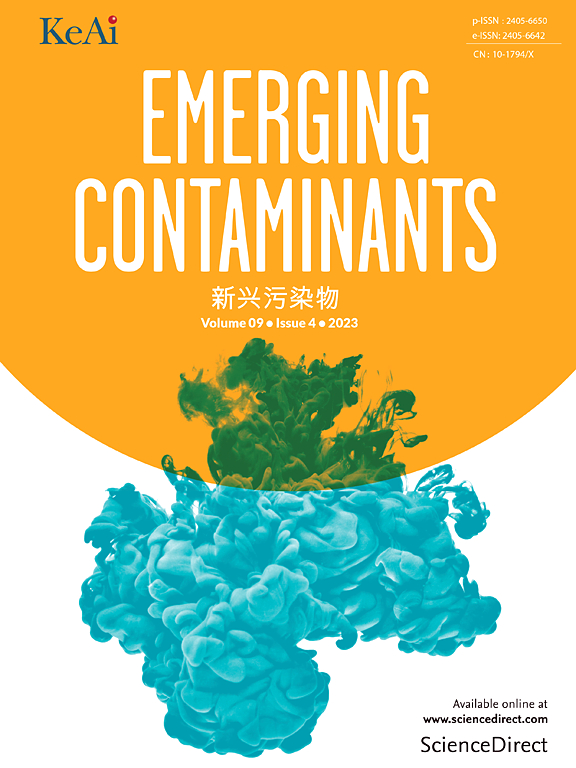Influence of anti-androgen cyproterone acetate on sperm characteristics, testosterone level, testicular and liver histology in male goldfish (Carassius auratus)
IF 6.9
2区 环境科学与生态学
Q1 ENVIRONMENTAL SCIENCES
引用次数: 0
Abstract
Cyproterone acetate (CA), a synthetic anti-androgen, was injected intraperitoneally into fish at two doses (5 and 50 mg/kg body weight) to evaluate its effects on physiological, biochemical, and reproductive parameters. A total of 180 fish were divided into three groups: Control (C), low-dose (LCA), and high-dose (HCA), with two replicates per group. Fish were observed daily for behavior, and water quality was controlled throughout the study. After 28-days of exposure, blood samples were collected to analyze plasma biochemical parameters. Sperm motility, concentration, and histological analyses of testes and liver tissues were also conducted. Results showed a significant dose-dependent decrease in cholesterol, triglycerides, and testosterone levels in the CA-treated groups, with the highest reduction observed in the HCA group (P < 0.05). Sperm motility was significantly reduced in the low-dose (66.1 ± 2.2 %) and high-dose (36.5 ± 3.9 %) groups compared to the control group (79.5 ± 2.2 %). Similarly, sperm concentration and motility time were significantly reduced in the CA-treated groups (P < 0.05). The gonadosomatic index (GSI) also decreased significantly in the treated groups, with the HCA group showing the lowest GSI (P < 0.05), indicating impaired gonadal development. Histological analysis of the testes revealed delayed spermatogenesis, with the HCA group predominantly showing immature gonadal stages (Stage II), and a significant reduction in spermatocytes and spermatozoa. Liver histology indicated necrosis, cell death, blood congestion, and vacuolization in both the LCA and HCA groups, particularly at the high dose (P < 0.05), suggesting hepatotoxicity. In conclusion, CA exerted significant endocrine-disrupting effects in fish, impairing sperm motility, gonadal development, and liver function in a dose-dependent manner. The high-dose treatment caused pronounced effects, including hepatocellular injury and a severe decline in reproductive health. These findings highlight the potential risks of cyproterone acetate as an endocrine disruptor and emphasize the importance of its effects on aquatic species, particularly in ecotoxicological assessments.
抗雄激素乙酸环丙孕酮对雄性金鱼精子特征、睾酮水平及睾丸和肝脏组织学的影响
将合成抗雄激素醋酸环丙孕酮(Cyproterone acetate, CA)按5和50 mg/kg体重两种剂量腹腔注射给鱼,以评价其对生理、生化和生殖参数的影响。将180尾鱼分为对照组(C)、低剂量组(LCA)和高剂量组(HCA),每组2个重复。研究人员每天观察鱼的行为,并在整个研究过程中控制水质。暴露28天后,采集血样分析血浆生化参数。精子活力、浓度、睾丸和肝脏组织的组织学分析也进行了。结果显示,在ca治疗组中,胆固醇、甘油三酯和睾酮水平有明显的剂量依赖性下降,HCA组的下降幅度最大(P <;0.05)。与对照组(79.5±2.2%)相比,低剂量组(66.1±2.2%)和高剂量组(36.5±3.9%)精子活力显著降低。同样,ca处理组的精子浓度和活动时间显著降低(P <;0.05)。各治疗组的促性腺指数(GSI)也显著降低,其中HCA组的GSI最低(P <;0.05),表明性腺发育受损。睾丸的组织学分析显示精子发生延迟,HCA组主要表现为未成熟性腺阶段(II期),精母细胞和精子显著减少。肝脏组织学显示LCA组和HCA组均出现坏死、细胞死亡、血液充血和空泡化,特别是在高剂量时(P <;0.05),提示肝毒性。综上所述,CA对鱼类具有显著的内分泌干扰作用,以剂量依赖的方式损害精子活力、性腺发育和肝功能。高剂量治疗造成了显著影响,包括肝细胞损伤和生殖健康严重下降。这些发现强调了醋酸环丙孕酮作为内分泌干扰物的潜在风险,并强调了其对水生物种影响的重要性,特别是在生态毒理学评估中。
本文章由计算机程序翻译,如有差异,请以英文原文为准。
求助全文
约1分钟内获得全文
求助全文
来源期刊

Emerging Contaminants
Medicine-Public Health, Environmental and Occupational Health
CiteScore
10.00
自引率
6.70%
发文量
35
审稿时长
44 days
期刊介绍:
Emerging Contaminants is an outlet for world-leading research addressing problems associated with environmental contamination caused by emerging contaminants and their solutions. Emerging contaminants are defined as chemicals that are not currently (or have been only recently) regulated and about which there exist concerns regarding their impact on human or ecological health. Examples of emerging contaminants include disinfection by-products, pharmaceutical and personal care products, persistent organic chemicals, and mercury etc. as well as their degradation products. We encourage papers addressing science that facilitates greater understanding of the nature, extent, and impacts of the presence of emerging contaminants in the environment; technology that exploits original principles to reduce and control their environmental presence; as well as the development, implementation and efficacy of national and international policies to protect human health and the environment from emerging contaminants.
 求助内容:
求助内容: 应助结果提醒方式:
应助结果提醒方式:


